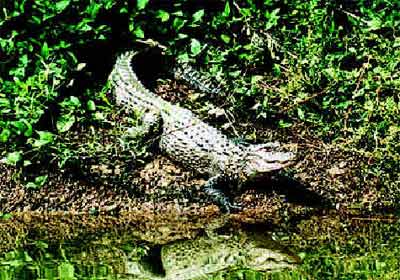Chinese alligators are making a comeback, according to experts with the State Forestry Administration, since a program to boost their dwindling numbers was launched in 2003.
The administration reported on Thursday that three Chinese alligators, two females and one male, that were released into the wild four years ago in Anhui Province, had successfully adapted to their new home. During the period, 105 eggs were hatched.
Experts called this a milestone accomplishment in promoting population growth for the endangered creature.
The Chinese alligator, also known as Yangtze alligator, lived in large numbers more than 230 million years ago, particularly on the eastern seaboard. An adult one could measure up to two meters in length. The reptile is nicknamed a "living fossil" and is considered as rare as the giant panda.
"Yangtze alligators were still reasonably common until the 1980s but as local people turned forests into farmlands, the animals disappeared," said 78-year-old Hu Dahua, a resident of Gaojingmiao, site of the State Forest Farm in Anhui Province that is also a nature reserve for the alligators.
Since 2003, scientists have released 15 captive-bred Chinese alligators on three separate occasions. In June, six were released in Anhui Province.
"Scientists will monitor the six alligators through a wireless tracking devices for 18 months," said Wang Chaolin, vice director of the Chinese Alligators Breeding Research Center.
A 2005 survey found that about 120 Chinese alligators were living in the wild, mostly in the Anhui Province nature reserve.
Over the past two years, about 100 alligators are believed to have been born in the wild, said sources at the center.
Wang said the center was keen to see a population of at least 500 wild Chinese alligators, a number that would mark a true success in restoring the species. He added the center's release activities would spur further population growth.
The Chinese government has put the reptile at the top of its protection list. In 1979, it set up the Chinese Alligator Breeding Research Center in Anhui Province. Since then, the number of alligators at the center has risen from about 200 to more than 10,000 at present. The center said it could hatch about 1,500 reptiles annually.
The Chinese alligator is now safe from extinction, according to Wang, but is still listed as one of the world's most endangered creatures.
(Xinhua News Agency November 2, 2007)






